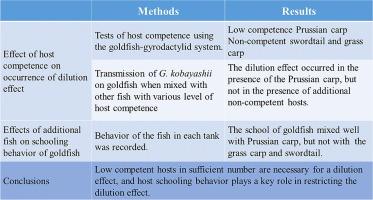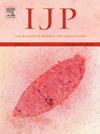宿主能力和学校行为对宿主-病原体系统中寄生虫传播的潜在影响:稀释效应测试。
IF 3.7
2区 医学
Q1 PARASITOLOGY
引用次数: 0
摘要
群落中物种的高度多样性可能会降低传染病的风险,这被称为稀释效应。然而,稀释效应在不同疾病系统中的普遍性仍然存在争议,因为宿主的能力和行为都可能在稀释或放大疾病方面发挥作用。研究人员利用金鱼(Carassius auratus)-单基因外寄生虫(Gyrodactylus kobayashii)系统,在保持焦点寄生虫密度不变的情况下,研究了寄生虫传播中宿主能力和游动行为的影响。在对作为寄生虫潜在宿主的 12 种鱼类进行能力测试之后,根据其宿主能力水平(包括普氏鲫(低能力)、草鱼(无能力)、剑尾鱼(无能力)以及四种鱼类的总和),分别测定了与三种不同鱼类混合的金鱼鳍上的小林天牛感染情况。在为期 11 天的实验中,与对照组金鱼身上的平均虫量(85.8 ± 25.1)相比,金鱼身上的平均虫量在与 10 条普氏鲤配对时显著下降(30.0 ± 16.5),但在与 10 条剑尾(70.0 ± 22.2)、10 条草鱼(116.1 ± 33.2)或 3 条普氏鲤、4 条草鱼和 3 条剑尾的多鱼种(75.9 ± 30.8)配对时没有显著差异。在普氏鲤组和多鱼种组的普氏鲤身上也发现了寄生虫,平均数量分别为 7.1 条和 10.9 条。视频记录显示,金鱼群与普氏鲤混养得很好,而与草鱼和剑尾鱼混养时则保持了一定的距离。各组金鱼之间的距离随着其他鱼种的增加而增加,游泳速度和接触时间则随着其他鱼种的增加而减少。结果表明,足够数量的低能力宿主的存在是因相遇减少而产生稀释效应的必要条件,稀释效应也可能因金鱼在低能力宿主存在时的游动行为变化而增强。然而,由于寄生虫的专一性和不与金鱼群混合,非能力寄主的存在不会导致任何稀释效应。本文章由计算机程序翻译,如有差异,请以英文原文为准。

Potential effects of host competence and schooling behavior on parasite transmission in a host-pathogen system: a test of the dilution effect
High species diversity in a community may reduce the risk of infectious disease, termed the dilution effect. However, the generality of the dilution effect in different disease systems remains controversial as both host competence and behaviors of hosts may play roles in dilution or amplification of disease. Using the goldfish (Carassius auratus)-monogenean ectoparasite (Gyrodactylus kobayashii) system, effects of host competence and schooling behavior on parasite transmission were investigated while holding focal host density constant. Following competency tests of 12 fish species as potential hosts for the parasite, infection by G. kobayashii was determined on fins of goldfish mixed with each of three different species based on their level of host competence, including Prussian carp, Carassius gibelio (low competence), grass carp, Ctenopharyngodon idellus (non-competent), swordtail, Xiphophorus helleri (non-competent), and the four species combined. Compared with mean abundance (85.8 ± 25.1) on goldfish in the control group, the mean abundance on goldfish decreased significantly when paired with 10 Prussian carp (30.0 ± 16.5), but did not differ significantly when paired with 10 swordtail (70.0 ± 22.2), 10 grass carp (116.1 ± 33.2), or the multi-species of three Prussian carp, four grass carp and three swordtail (75.9 ± 30.8) during the 11-day experiment. The parasite was also found on the Prussian carp in the Prussian carp group and the multi-species group at a mean abundance of 7.1 and 10.9, respectively. Video recording showed that the school of goldfish mixed well with the Prussian carp, while they maintained separation from the grass carp and swordtail when mixed together. The distance between goldfish increased, and swimming speed and contact time decreased with the additional of other fish species for all groups. The results suggested that the presence of a low-competence host in sufficient numbers was a necessary condition for a dilution effect due to encounter reduction, and the dilution effect may also be enhanced by changes in schooling behavior of goldfish in the presence of low competence hosts. However, the presence of non-competent hosts did not result in any dilution effect owing to the specialist nature of the parasites and the lack of mixing with schools of goldfish.
求助全文
通过发布文献求助,成功后即可免费获取论文全文。
去求助
来源期刊
CiteScore
8.40
自引率
2.50%
发文量
76
审稿时长
23 days
期刊介绍:
International Journal for Parasitology offers authors the option to sponsor nonsubscriber access to their articles on Elsevier electronic publishing platforms. For more information please view our Sponsored Articles page. The International Journal for Parasitology publishes the results of original research in all aspects of basic and applied parasitology, including all the fields covered by its Specialist Editors, and ranging from parasites and host-parasite relationships of intrinsic biological interest to those of social and economic importance in human and veterinary medicine and agriculture.

 求助内容:
求助内容: 应助结果提醒方式:
应助结果提醒方式:


